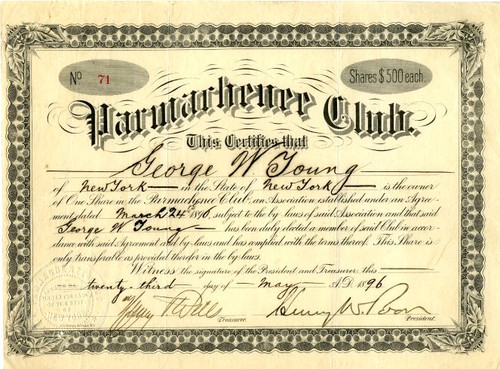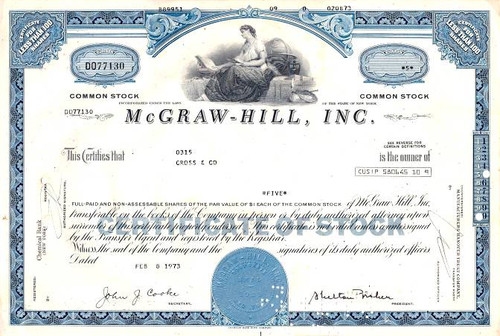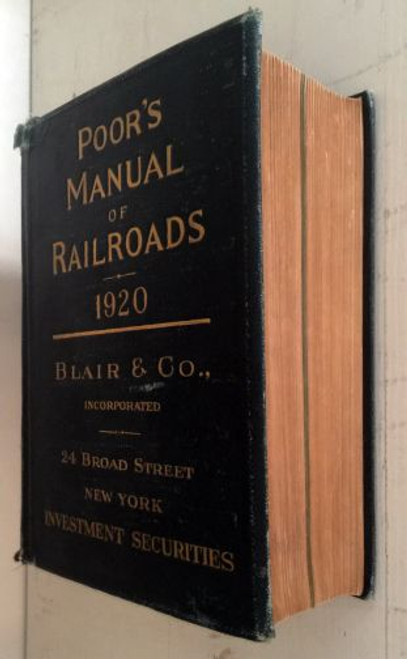Beautiful RARE stock certificate from the Parmachenee Club issued in 1896. This historic document has an ornate border around it with the organization's name om top center. This item has the signatures of the Company's President, Henry W. Poor and Secretary, Henry Parkhurst Wells. 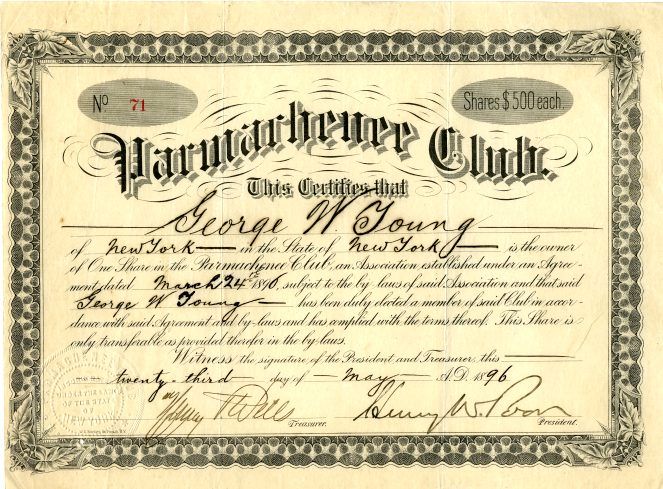
Certificate 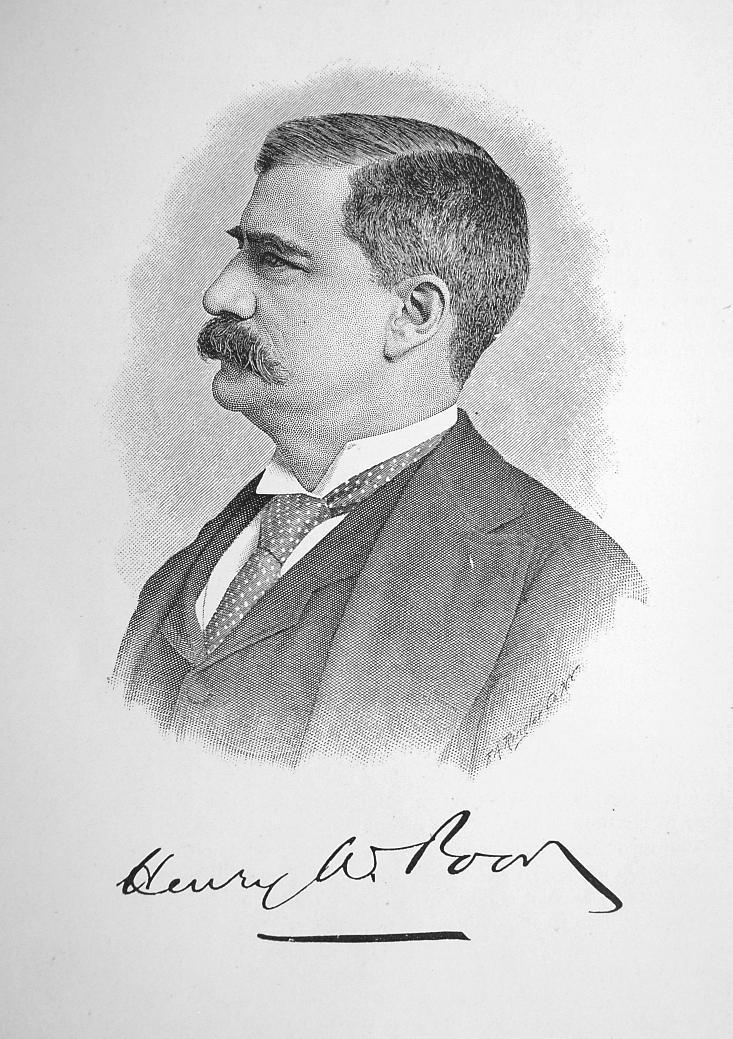
This is a portrait print from book in 1895 - Printed signature. The Parmachenee Club was a private hunting-fishing club for wealth gentlemen on Treat's Island at Parmachenee Lake in Maine. Henry William Poor (June 16, 1844 - April 1915) was an American banker, stockbroker, and author. Henry William Poor was born in Bangor, Maine, in 1844, the son of Henry Varnum Poor. The family moved to New York City when he was five years old, and he spent his youth there. He attended Harvard College, graduating in 1865. The firm that he and his father established in 1868, H. V. & H. W. Poor, was a predecessor to the business that eventually became Standard & Poor's. Henry William Poor became prominent as a stockbroker and investor, but had to liquidate his business in 1908 following some major losses. He was also widely known as a book collector and a patron of the arts. Poor died in New York City in April 1915. Henry P. Wells invented the famous Parmacheene Belle fishing fly in 1876.
The Parmachenee Club was formed in 1890 to lease 120,000 acres (49,000 ha) of commercial forest land extending south from the Canadian border where they built a camp in the meadows along the Magalloway River. Club members lodged at the camp while engaged in sport hunting and angling. The meadows and camp were seasonally flooded by a log driving dam built by Brown Mills Company and International Paper Company. Camp Caribou was originally a floating camp built by John Danforth who in 1870 relocated the camp to Treat's Island. In 1890 it was sold to the Parmachenee Club who expanded the facility with a farm house and farm on the East shore and a fish hatchery. Camp Caribou eventually consisted of a main lodge, maids' quarters, quides' quarters, a large woodshed and 13 individual family cabins. They also developed a hillside spring that was piped across the lake to the Club. As angling opportunities declined on more accessible lakes before the advent of fishing licenses, fishing seasons, slot limits, and creel limits, the nearly aboriginal conditions of the private reserve of the Parmachenee Club became legendary among outdoor writers. Parmachenee Lake became a vacation retreat for the United States' industrial and political elite. One of the last visitors, before the club disbanded in the 1960s, was President Dwight D. Eisenhower[5] in 1952 who slept in Cabin 5. The Brown Company eventually bought the property and used it as a Corporate retreat. The Island was then leased to a private individual and has been seasonally occupied since then.
Biography of Henry William Poor (from America's Successful Men of Affairs, 1895) Source: Hall, Henry, ed.. America's Successful Men of Affairs: An Encyclopedia of Contemporaneous Biography, pp. 512-513. New York, USA: The New York Tribune, 1895-96. HENRY WILLIAM POOR, banker, stock broker and author, a man thoroughly American in sentiment, an authority of world wide reputation in railway matters and statistics, and for character and accomplishments highly regarded, was born in Bangor, Me., June 16, 1844. All of his ancestors on both sides of the family originated in England and established themselves in Massachusetts in the earliest colonial times, where they shared in all the activities of their day for subduing the wilderness and the Indian tribes, planting a commonwealth, and creating in the new world a representative form of government Ezekiel Merrill, great-grandfather of Mr. Poor on his father's side, held a commission as an officer and wielded a sword bravely in the American Revolution. He served in Colonel Gerrish's regiment, April 19, 1775, when the Minute Men in New England were summoned, at the time of the Lexington alarm, to withstand the aggressions of the British troops, and had the honor to be present in the American army at the time of Burgoyne's surrender at Saratoga, Oct. 17, 1777. In 1785, this old Revolutioner moved to Andover, Me., situated among the mountains of Oxford county near the Rangeley Lakes and there, in 1791, built the Merrill House, an old homestead of the colonial style, which is now owned by the subject of this biography and occupied by him as one of his country seats. Benjamin Franklin, great great uncle of Mr. Poor on his mother's side, performed services in the period of the struggle for independence, which are historic and require no further mention. On his mother's side, also, Mr. Poor is a grandson of the Rev. John Pierce, who presided over the first parish church in Brookline, Mass., for over fifty years and was a prominent figure in the annals of Harvard University, his picture occupying a conspicuous position in Memorial Hall at Cambridge, Mass.[p.512] His father, Henry V. Poor, a graduate, in 1835, of Bowdoin College, Maine, was a lawyer in Bangor, Me., until 1849, when he moved with his family to New York and was well known in this city in railway affairs and as editor of The American Railroad Journal, which he conducted until 1863. In 1865, he retired from active life and moved to Brookline, Mass. Since then, he has become the author of various financial and statistical works of great value and is yet living in a hale, hearty old age, greatly respected by all who know him. Mr. Poor received a preliminary education in New York city, to which place he was brought when five years old, and graduated from Harvard College in the class of 1865. He entered upon the serious work of his career immediately on graduating, returning to New York city in August of 1865, and has ever since made the metropolis his home. Finding occupation at once as clerk in the then stock brokerage firm of Henry Fitch & Co., he learned in that house all the technicalities of the brokerage business and soon gained sufficient confidence to engage in business on his own account. Any man of receptive and tenacious mind, who is inspired with the least particle of determination not to remain in a rut but to make his own way in the world, will in due time leave a subordinate position and display to the world the sign, which announces that he is in business for himself. Mr. Poor's period of probation was an unusually short one, and in 1868, he established himself in business under the firm name H. V. & H. W. Poor in this city as a dealer in railroad securities. He then associated with himself the Hon. C. E. Habicht, Consul General of Norway and Sweden, in the importation of railroad iron as correspondent of the firm of Tiden, Nordenfelt & Co., of London. Mr. Nordenfelt became the maker of the heavy ordnance known as the "Nordenfelt gun" for the British Government. Mr. Poor's connection with this branch of the business, through the necessity of keeping a record of all railway companies and new construction undertaken by them so that he might be the first in the field in negotiation for the rails needed by them, led to the establishment by him, in 1868, of the now famous annual publication known as "Poor's Railroad Manual," which has ever since filled an important place in the railroad world. Embodying as it does, exhaustive financial information concerning every railway company on the continent, it is an absolute necessity to every manager of an American railroad, every operator in railroad shares and every statistician and writer on economic questions and is as well known in Europe as in this country. Mr. Poor gave extremely close study to the subject to which the Manual was devoted, and soon rose to the position of an authority upon railroad statistics. The firm of H. V. & H. W. Poor is yet in existence at No. 44 Broad street, as publishers of the "Railroad Manual" and other statistical works, Henry W. Poor having been the sole partner, however, since 1883. The period in which Mr. Poor made his entrance into affairs was one of great activity in financial circles. The Civil War had come to an end, railroad building was the order of the day, the country was animated with a spirit of restless enterprise and Wall street became the centre of exciting operations. The firm of H. V. & H. W. Poor prospered from year to year and undertook the construction of several lines of railway, and the junior partner gradually gained the capital to engage in a regular banking business. The now well known banking firm, of which Mr. Poor is the senior partner, was [p.514] organized in 1880, under the name of Anthony, Poor & Oliphant. They located their office at No. 19 Broad street and attracted important clients from the start. Various transmutations have since occurred in the personnel of the firm. In 1881, they organized as Poor, Oliphant & Co., changed to Poor & Oliphant in 1882, and taking the name of Poor, White & Co., in 1883, upon the addition to it of B. Ogden White, who had been for twenty years the secretary of the New York Stock Exchange. In 1884, the name was again changed to Poor, White & Greenough by accession of John Greenough, a classmate of Mr. Poor in Harvard College, and who formerly had been a leading merchant in the South American business, in which he had accumulated a fortune. In 1886, the name was changed to Poor & Greenough, the title of the present firm. The house has always managed its affairs with prudence, energy and ability and is now prominent in Wall street, both partners being rated as millionaires. It represents a number of important foreign interests and corporations, has extensive English and continental connections, deals largely in railway and other securities, having issued upward of $100,000,000 of railway loans, has borne a part in important railroad reorganizations, and has acted as financial agents of The Louisville, New Albany & Chicago Railway, The New York, Ontario & Western Railway, The Missouri, Kansas & Texas Railway and many other corporations. Mr. Poor purchased a seat in the Stock Exchange, Oct. 2, 1890, and individually has made investments in and been active in the management of a large number of corporations, in which his counsel has been desired. He is at the present time president of The Kansas City & Pacific Railway; an active director of The Missouri, Kansas & Texas Railway; a director of The Bank of the State of New York, and chairman of The Sherman, Shreveport & Southern Railway; and a director of The United States Casualty Co., and the Consolidated Ice Co. He has also been connected at various times with many other corporations in an official capacity. Mr. Poor is a man of refined and scholarly tastes and prominent in the social life of the city. He is an ardent student and a great lover of books and has, by careful and gradual accumulation, collected one of the finest private libraries in the city of New York; and he maintains his vigor for business pursuits by recreation in the open air, having been distinguished in youth for prominence in athletic sports and great physical strength. Among the clubs of which he is, or has been, a member are the Union League, Harvard, University, Players', Tuxedo, Country, Lawyers', Down Town, Riding, Racquet & Tennis, Seawanhaka Corinthian Yacht, American Yacht, Rockaway Hunting, Oval, Aldine, Grolier, Barnard, Lotos, City, Vaudeville, Arkwright, Lawrence, New York Athletic and Mendelssohn Glee of this city, and the Algonquin of Boston. He was the first president (1894) of Good Government Club F, and is treasurer of the Parmachenee club, a sporting club in Maine. By virtue of lineal descent from Ezekial Merrill above referred to, he is also a member of The Sons of the American Revolution in this State, and from public spirit and interest in their objects he became a member of The New York Historical Society, life member of The New England Society and The American Institute of Fine Arts, a member of The New York Geographical & Statistical Society, The Metropolitan Museum of Art and The American Museum of Natural History and The Hakluyt Society of London. He is also a director of The Symphony and Oratorio Societies and a member of The Musical Art Society. He was married Feb. 4, 1880, to Constance Brandon, and is the father of four children, [p.515] Henry V., born 1880; Edith, born 1882; Roger, born 1883, and Sylvia, born 1892.

Certificate

This is a portrait print from book in 1895 - Printed signature.
The Parmachenee Club was formed in 1890 to lease 120,000 acres (49,000 ha) of commercial forest land extending south from the Canadian border where they built a camp in the meadows along the Magalloway River. Club members lodged at the camp while engaged in sport hunting and angling. The meadows and camp were seasonally flooded by a log driving dam built by Brown Mills Company and International Paper Company. Camp Caribou was originally a floating camp built by John Danforth who in 1870 relocated the camp to Treat's Island. In 1890 it was sold to the Parmachenee Club who expanded the facility with a farm house and farm on the East shore and a fish hatchery. Camp Caribou eventually consisted of a main lodge, maids' quarters, quides' quarters, a large woodshed and 13 individual family cabins. They also developed a hillside spring that was piped across the lake to the Club. As angling opportunities declined on more accessible lakes before the advent of fishing licenses, fishing seasons, slot limits, and creel limits, the nearly aboriginal conditions of the private reserve of the Parmachenee Club became legendary among outdoor writers. Parmachenee Lake became a vacation retreat for the United States' industrial and political elite. One of the last visitors, before the club disbanded in the 1960s, was President Dwight D. Eisenhower[5] in 1952 who slept in Cabin 5. The Brown Company eventually bought the property and used it as a Corporate retreat. The Island was then leased to a private individual and has been seasonally occupied since then.
Biography of Henry William Poor (from America's Successful Men of Affairs, 1895) Source: Hall, Henry, ed.. America's Successful Men of Affairs: An Encyclopedia of Contemporaneous Biography, pp. 512-513. New York, USA: The New York Tribune, 1895-96. HENRY WILLIAM POOR, banker, stock broker and author, a man thoroughly American in sentiment, an authority of world wide reputation in railway matters and statistics, and for character and accomplishments highly regarded, was born in Bangor, Me., June 16, 1844. All of his ancestors on both sides of the family originated in England and established themselves in Massachusetts in the earliest colonial times, where they shared in all the activities of their day for subduing the wilderness and the Indian tribes, planting a commonwealth, and creating in the new world a representative form of government Ezekiel Merrill, great-grandfather of Mr. Poor on his father's side, held a commission as an officer and wielded a sword bravely in the American Revolution. He served in Colonel Gerrish's regiment, April 19, 1775, when the Minute Men in New England were summoned, at the time of the Lexington alarm, to withstand the aggressions of the British troops, and had the honor to be present in the American army at the time of Burgoyne's surrender at Saratoga, Oct. 17, 1777. In 1785, this old Revolutioner moved to Andover, Me., situated among the mountains of Oxford county near the Rangeley Lakes and there, in 1791, built the Merrill House, an old homestead of the colonial style, which is now owned by the subject of this biography and occupied by him as one of his country seats. Benjamin Franklin, great great uncle of Mr. Poor on his mother's side, performed services in the period of the struggle for independence, which are historic and require no further mention. On his mother's side, also, Mr. Poor is a grandson of the Rev. John Pierce, who presided over the first parish church in Brookline, Mass., for over fifty years and was a prominent figure in the annals of Harvard University, his picture occupying a conspicuous position in Memorial Hall at Cambridge, Mass.[p.512] His father, Henry V. Poor, a graduate, in 1835, of Bowdoin College, Maine, was a lawyer in Bangor, Me., until 1849, when he moved with his family to New York and was well known in this city in railway affairs and as editor of The American Railroad Journal, which he conducted until 1863. In 1865, he retired from active life and moved to Brookline, Mass. Since then, he has become the author of various financial and statistical works of great value and is yet living in a hale, hearty old age, greatly respected by all who know him. Mr. Poor received a preliminary education in New York city, to which place he was brought when five years old, and graduated from Harvard College in the class of 1865. He entered upon the serious work of his career immediately on graduating, returning to New York city in August of 1865, and has ever since made the metropolis his home. Finding occupation at once as clerk in the then stock brokerage firm of Henry Fitch & Co., he learned in that house all the technicalities of the brokerage business and soon gained sufficient confidence to engage in business on his own account. Any man of receptive and tenacious mind, who is inspired with the least particle of determination not to remain in a rut but to make his own way in the world, will in due time leave a subordinate position and display to the world the sign, which announces that he is in business for himself. Mr. Poor's period of probation was an unusually short one, and in 1868, he established himself in business under the firm name H. V. & H. W. Poor in this city as a dealer in railroad securities. He then associated with himself the Hon. C. E. Habicht, Consul General of Norway and Sweden, in the importation of railroad iron as correspondent of the firm of Tiden, Nordenfelt & Co., of London. Mr. Nordenfelt became the maker of the heavy ordnance known as the "Nordenfelt gun" for the British Government. Mr. Poor's connection with this branch of the business, through the necessity of keeping a record of all railway companies and new construction undertaken by them so that he might be the first in the field in negotiation for the rails needed by them, led to the establishment by him, in 1868, of the now famous annual publication known as "Poor's Railroad Manual," which has ever since filled an important place in the railroad world. Embodying as it does, exhaustive financial information concerning every railway company on the continent, it is an absolute necessity to every manager of an American railroad, every operator in railroad shares and every statistician and writer on economic questions and is as well known in Europe as in this country. Mr. Poor gave extremely close study to the subject to which the Manual was devoted, and soon rose to the position of an authority upon railroad statistics. The firm of H. V. & H. W. Poor is yet in existence at No. 44 Broad street, as publishers of the "Railroad Manual" and other statistical works, Henry W. Poor having been the sole partner, however, since 1883. The period in which Mr. Poor made his entrance into affairs was one of great activity in financial circles. The Civil War had come to an end, railroad building was the order of the day, the country was animated with a spirit of restless enterprise and Wall street became the centre of exciting operations. The firm of H. V. & H. W. Poor prospered from year to year and undertook the construction of several lines of railway, and the junior partner gradually gained the capital to engage in a regular banking business. The now well known banking firm, of which Mr. Poor is the senior partner, was [p.514] organized in 1880, under the name of Anthony, Poor & Oliphant. They located their office at No. 19 Broad street and attracted important clients from the start. Various transmutations have since occurred in the personnel of the firm. In 1881, they organized as Poor, Oliphant & Co., changed to Poor & Oliphant in 1882, and taking the name of Poor, White & Co., in 1883, upon the addition to it of B. Ogden White, who had been for twenty years the secretary of the New York Stock Exchange. In 1884, the name was again changed to Poor, White & Greenough by accession of John Greenough, a classmate of Mr. Poor in Harvard College, and who formerly had been a leading merchant in the South American business, in which he had accumulated a fortune. In 1886, the name was changed to Poor & Greenough, the title of the present firm. The house has always managed its affairs with prudence, energy and ability and is now prominent in Wall street, both partners being rated as millionaires. It represents a number of important foreign interests and corporations, has extensive English and continental connections, deals largely in railway and other securities, having issued upward of $100,000,000 of railway loans, has borne a part in important railroad reorganizations, and has acted as financial agents of The Louisville, New Albany & Chicago Railway, The New York, Ontario & Western Railway, The Missouri, Kansas & Texas Railway and many other corporations. Mr. Poor purchased a seat in the Stock Exchange, Oct. 2, 1890, and individually has made investments in and been active in the management of a large number of corporations, in which his counsel has been desired. He is at the present time president of The Kansas City & Pacific Railway; an active director of The Missouri, Kansas & Texas Railway; a director of The Bank of the State of New York, and chairman of The Sherman, Shreveport & Southern Railway; and a director of The United States Casualty Co., and the Consolidated Ice Co. He has also been connected at various times with many other corporations in an official capacity. Mr. Poor is a man of refined and scholarly tastes and prominent in the social life of the city. He is an ardent student and a great lover of books and has, by careful and gradual accumulation, collected one of the finest private libraries in the city of New York; and he maintains his vigor for business pursuits by recreation in the open air, having been distinguished in youth for prominence in athletic sports and great physical strength. Among the clubs of which he is, or has been, a member are the Union League, Harvard, University, Players', Tuxedo, Country, Lawyers', Down Town, Riding, Racquet & Tennis, Seawanhaka Corinthian Yacht, American Yacht, Rockaway Hunting, Oval, Aldine, Grolier, Barnard, Lotos, City, Vaudeville, Arkwright, Lawrence, New York Athletic and Mendelssohn Glee of this city, and the Algonquin of Boston. He was the first president (1894) of Good Government Club F, and is treasurer of the Parmachenee club, a sporting club in Maine. By virtue of lineal descent from Ezekial Merrill above referred to, he is also a member of The Sons of the American Revolution in this State, and from public spirit and interest in their objects he became a member of The New York Historical Society, life member of The New England Society and The American Institute of Fine Arts, a member of The New York Geographical & Statistical Society, The Metropolitan Museum of Art and The American Museum of Natural History and The Hakluyt Society of London. He is also a director of The Symphony and Oratorio Societies and a member of The Musical Art Society. He was married Feb. 4, 1880, to Constance Brandon, and is the father of four children, [p.515] Henry V., born 1880; Edith, born 1882; Roger, born 1883, and Sylvia, born 1892.


